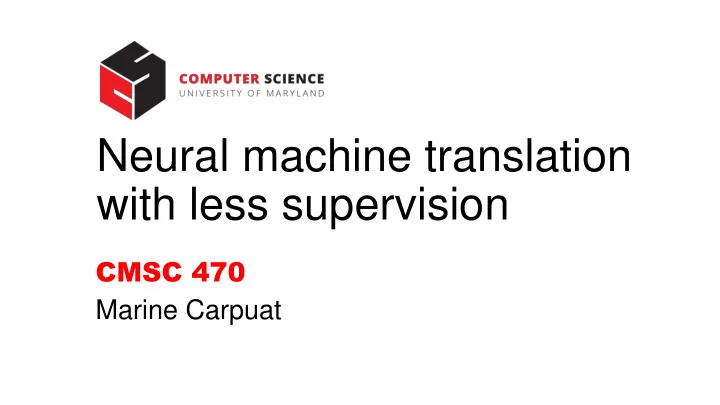

Neural machine translation with less supervision CMSC 470 Marine Carpuat
Neural MT only helps in high-resource settings Ongoing research • Learn from other sources of supervision than pairs (E,F) • Monolingual text • Multiple languages [Koehn & Knowles 2017]
Neural Machine Translation Standard Training is Supervised We are provided with pairs ( x , y ) where y ts the ground truth for • each sample x x = Chinese sentence y = translation of x in English written by a human What is the training loss? •
Unsupervised learning No labels for training samples • E.g., we are provided with Chinese sentences x , or English sentences y , but • no (x,y) pairs Goal: uncover latent structure in unlabeled data •
Semi-supervised learning Uses both annotated and unannotated data • (x,y) Chinese-English pairs • Chinese sentences x , and/or English sentences y • Combines • Direct optimization of supervised training objective • Better modeling of data with cheaper unlabeled examples •
Semi-supervised NMT
Using Monolingual Corpora in Neural Machine Translation [Gulcehre et al. 2015] Slides credit: Antonis Anastasopoulos (CMU)
Approach 1: Shallow Fusion Use a language model to rescore translation candidates from the NMT decoder
Approach 2: Deep Fusion Integrate RNN language model and NMT model by concatenating their hidden states
Using Monolingual Corpora via Backtranslation [Sennrich et al. 2015] Slides credit: Antonis Anastasopoulos (CMU)
Backtranslation • Pros • Simple approach • No additional parameters • Cons • Computationally expensive • to train an auxiliary NMT model for back-translation • to translate large amounts of monolingual corpora
Combining Multilingual Machine Translation and Backtranslation [Niu et al. 2018]
Experiments: 3 language pairs x 2 directions
Experiments: impact on BLEU
Experiments: impact on training updates
Combining Multilingual Machine Translation and Backtranslation [Niu et al. 2018] • A single NMT model with standard architecture performs both forward and backward translation during training • Significantly reduces training costs compared to uni-directional systems • Improves translation quality for low-resource language pairs
Another idea: use monolingual data to pre- train model components Slides credit: Antonis Anastasopoulos (CMU)
Another idea: use monolingual data to pre- train model components • Encoder can be pre-trained as language model • Decoder can be pre-trained as language model • Word embeddings can be pre-trained using word2vec or other objectives • But impact is mixed in practice because of mismatch between pre- training and NMT objectives
3 strategies for semi-supervised neural MT • Incorporate a target language model p(y) via shallow or deep fusion • Create synthetic pairs (x*,y) via backtranslation • Pre-train encoder, decoder or embeddings on monolingual data x or y
Unsupervised NMT
Translation as decipherment Slides credit: Antonis Anastasopoulos (CMU)
Unsupervised Machine Translation [Lample et al.; Artetxe et al. 2018] Slides credit: Antonis Anastasopoulos (CMU)
Aside: (noisy) bilingual lexicons can be induced from bilingual embeddings • One method: bilingual skipgram model • put words from 2 (or more) languages into the same embedding space • cosine similarity can be used to find translations in the 2 nd language, in addition to similar/related words in the 1 st language Slides credit: Antonis Anastasopoulos (CMU)
Aside: (noisy) bilingual lexicons can be induced from bilingual embeddings One approach: bilingual skipgram model Requires word aligned parallel data Skipgram embeddings are trained to predict - Neighbors of words w1 in language 1 (e.g., German) - Neighbors of words w2 in language 2 (e.g., English) - Language 1 neighbors of word w1 - Language 1 neighbors of word w2 Luong et al. (2015): https://nlp.stanford.edu/~lmthang/bivec/
Unsupervised objectives intuition: auto-encoding + back-translation Figure from Lample et al. ICLR 2018
Experiments Figure from Lample et al. ICLR 2018
Experiments Figure from Lample et al. ICLR 2018
Experiments Figure from Lample et al. ICLR 2018
Unsupervised neural MT • Given a bilingual embeddings / translation lexicon, it is possible to train a neural MT system without examples of translated sentences! • But current evidence is limited to simulations on high resource languages, and sometimes parallel data • Unclear how well results port to realistic low-resource scenarios
Recommend
More recommend